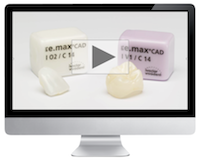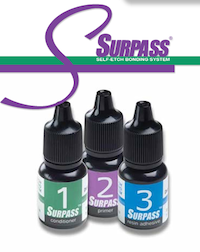 Impulse e.max adds additional options for shade selection and clinical applications. There are three Value blocks and two Opal blocks. The Value blocks are recommended for crowns, veneers, and partial crowns (value increases from V1 to V3). The block match is determined by brightness. The Opal blocks are indicated for thin veneers. Download the PDF to view firing cycle (which is different than the HT and LT e.max
Impulse e.max adds additional options for shade selection and clinical applications. There are three Value blocks and two Opal blocks. The Value blocks are recommended for crowns, veneers, and partial crowns (value increases from V1 to V3). The block match is determined by brightness. The Opal blocks are indicated for thin veneers. Download the PDF to view firing cycle (which is different than the HT and LT e.max
Submitted by James Klim DDS, CADStar host on 01/22/2012 - 11:25pm
Submitted by James Klim DDS, CADStar host on 11/23/2011 - 2:29pm
 Keep an eye on 3M LAVA Ultimate (view LAVA webcast). My first few experiences have been impressive. I used it six times this last week with incredible fits. My current 3M LAVA Ultimate
Keep an eye on 3M LAVA Ultimate (view LAVA webcast). My first few experiences have been impressive. I used it six times this last week with incredible fits. My current 3M LAVA Ultimate
Submitted by James Klim DDS, CADStar host on 11/13/2011 - 1:14pm


OptiBond XTR (Kerr Self-Etch, Light-Cure Universal Adhesive) ... I am very cautious about switching and recommending a new bonding agent. There are credible reviews sanctioning the approval for Optibond XTR as a credible adhesive system. This is an impressive system that provides universal compatibility
Submitted by James Klim DDS, CADStar host on 11/13/2011 - 12:34pm
The Clear Shot delivers clearer images with less corrupt data. It also stabilizes the field for quicker image taking. The use of the Isolation wings not only retract the cheek and tongue, it also traps the light and concentrates it where it is needed the most.
Submitted by James Klim DDS, CADStar host on 10/24/2011 - 11:15pm
http://apexdentalmaterials.com/surpass/
Instructions for sealing the preparation before optical impression / Protocol for the Delivery of a CAD/CAM (or all ceramic) Restoration: Preparing the Tooth:
Submitted by James Klim DDS, CADStar host on 09/25/2011 - 7:58pm
Keep an eye on this CAD/CAM material. Still looking for solid wear and tear research. The possibility is promising.
Submitted by James Klim DDS, CADStar host on 06/16/2011 - 1:20pm
 TrollFoil™ is a very sensitive pre-mounted articulating foil. At only 8 micrometers thick it is the thinnest marking paper that I am aware of. The pre-mounted presentation of TrollFoil™ makes it quick and efficient to use and negates the need for mounting forceps. TrollFoil™ marks on highly polished porcelain (e.max) or gold crowns. TrollFoil™ has ink on both sides of the foil.
TrollFoil™ is a very sensitive pre-mounted articulating foil. At only 8 micrometers thick it is the thinnest marking paper that I am aware of. The pre-mounted presentation of TrollFoil™ makes it quick and efficient to use and negates the need for mounting forceps. TrollFoil™ marks on highly polished porcelain (e.max) or gold crowns. TrollFoil™ has ink on both sides of the foil.
TrollFoil™ is one of my nominations for best product of the year. Incredible for e
Submitted by James Klim DDS, CADStar host on 04/27/2011 - 4:52am
The robust nature of e.max is a game changer in CEREC. Wears like enamel but with functional behaviors stronger than a PFM.
Submitted by James Klim DDS, CADStar host on 03/11/2011 - 7:35pm
Not sure of the wear factor yet, but something to keep an eye on. The "bruxer" type of crown idea. With my experience thus far, e.max is definitely a reliable material for the challenged occlusal situation as long as there is adequate ceramic thickness. From what I am hearing in the industry, part of a material's wear compatibility factor is defined by the smoothness and polishability of the material. Zirconia is a very smooth material.
Submitted by James Klim DDS, CADStar host on 01/12/2011 - 3:43am


